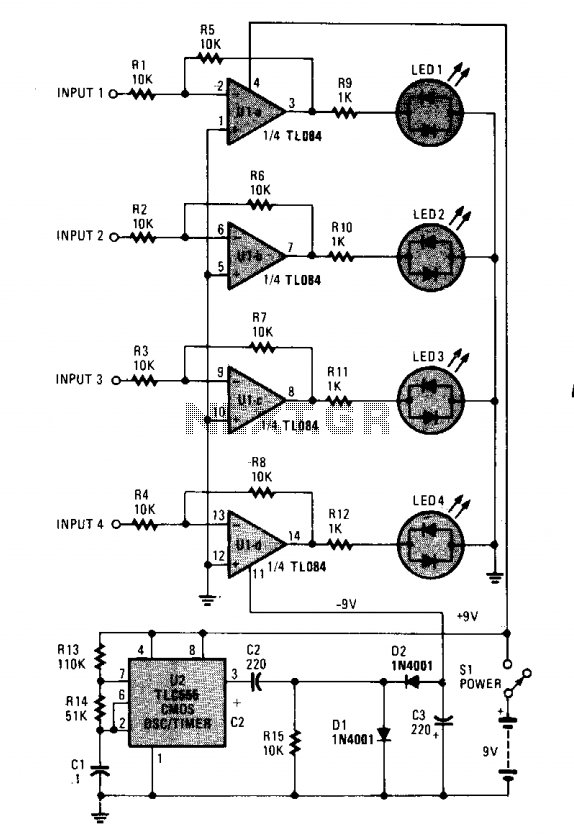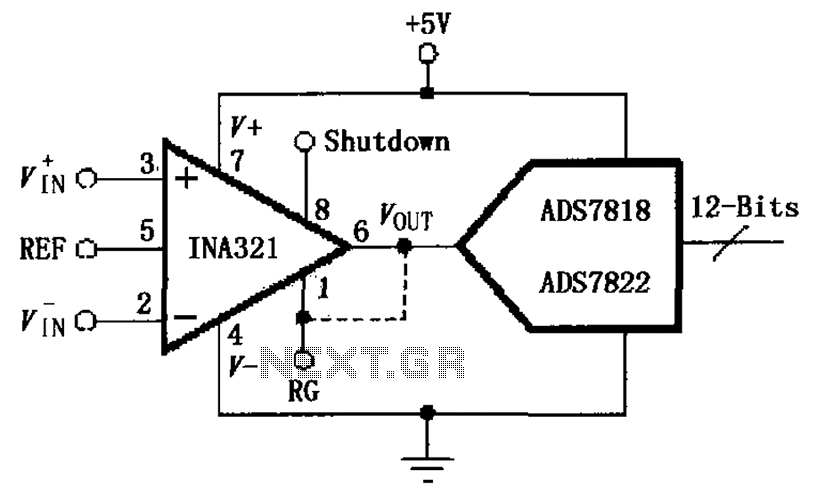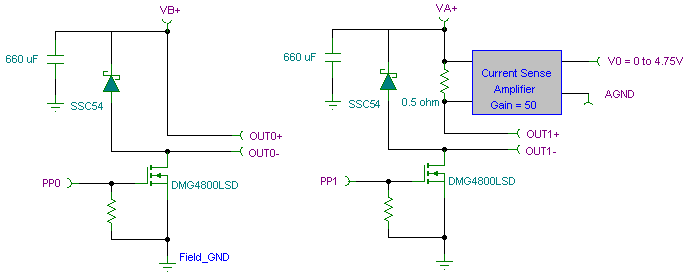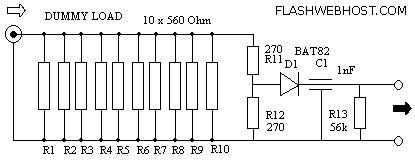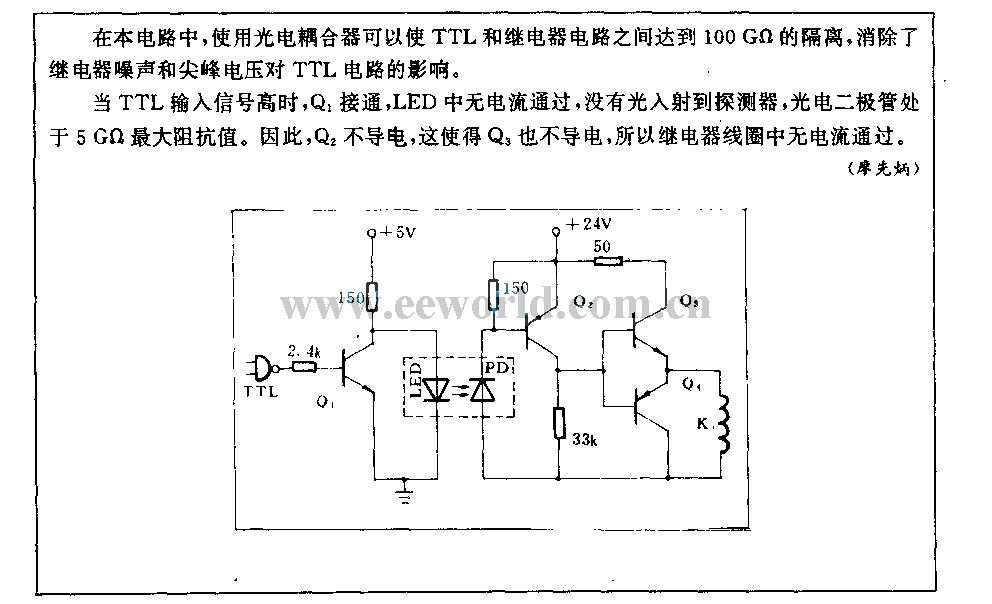
OPA606 capacitive load isolation buffer
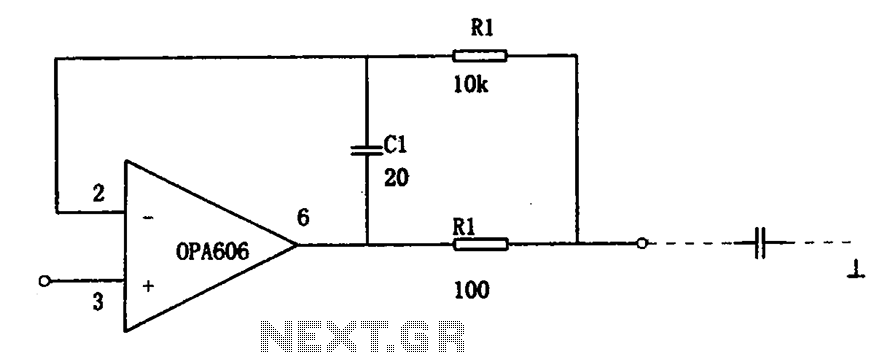
The isolation buffer circuit for capacitive loads is illustrated. When using an external operational amplifier (op-amp) with capacitive loads, the stability of the circuit is significantly affected, which leads to a degradation in dynamic performance. The circuit effectively demonstrates the capability of driving a capacitive load by utilizing a FET input type dielectric isolation wideband operational amplifier, specifically the OPA606, which functions as an isolation amplifier. This configuration, combined with an amplifying circuit, tends to idealize load capacity. The superior load capacity of this circuit can be attributed to the characteristics of the OPA606 and the inclusion of an RC compensation network in the external circuit. The schematic depicts a 10kΩ resistor (R1) in the access circuit and a compensation capacitor (C1) with a capacitance of 20pF.
The isolation buffer circuit is designed to enhance the performance of circuits that need to drive capacitive loads, which are often challenging due to stability issues. The OPA606 operational amplifier is selected for its high input impedance and low output impedance, which minimizes the loading effect on the preceding stage. This amplifier's FET input ensures a wide bandwidth and low noise, making it suitable for high-frequency applications.
The RC compensation network, consisting of the resistor R1 and capacitor C1, plays a critical role in stabilizing the circuit. The 10kΩ resistor helps to limit the current and sets the gain of the buffer stage, while the 20pF capacitor provides phase compensation, which is essential for maintaining stability when driving capacitive loads. Together, these components form a feedback loop that mitigates potential oscillations and ensures a smooth transient response.
In practical applications, this isolation buffer circuit can be employed in sensor interfacing, analog signal conditioning, and other scenarios where capacitive loads are present. The design allows for a robust response to varying load conditions while preserving signal integrity, making it a valuable addition to any electronic system requiring reliable performance under capacitive loading. As shown for the isolation buffer circuit capacitive load. Usually when an external op amp for capacitive load, will seriously affect the stability of the circuit, while its dy namic performance will be severely degraded, and was able to better illustrated circuit driving a capacitive load, because the circuit uses a FET input type dielectric isolation wideband operational amplifier OPA606 composed isolation amplifier, and amplifying circuit with a carrying capacity tends to idealize. The reason why this circuit has such a good load capacity, due to the OPA606 has its own characteristics and the external circuit of the RC compensation network.
The figure shows the resistance of the access circuit is 10k resistor R1 and the compensation capacitor C1 (with a capacity of 20pF).
The isolation buffer circuit is designed to enhance the performance of circuits that need to drive capacitive loads, which are often challenging due to stability issues. The OPA606 operational amplifier is selected for its high input impedance and low output impedance, which minimizes the loading effect on the preceding stage. This amplifier's FET input ensures a wide bandwidth and low noise, making it suitable for high-frequency applications.
The RC compensation network, consisting of the resistor R1 and capacitor C1, plays a critical role in stabilizing the circuit. The 10kΩ resistor helps to limit the current and sets the gain of the buffer stage, while the 20pF capacitor provides phase compensation, which is essential for maintaining stability when driving capacitive loads. Together, these components form a feedback loop that mitigates potential oscillations and ensures a smooth transient response.
In practical applications, this isolation buffer circuit can be employed in sensor interfacing, analog signal conditioning, and other scenarios where capacitive loads are present. The design allows for a robust response to varying load conditions while preserving signal integrity, making it a valuable addition to any electronic system requiring reliable performance under capacitive loading. As shown for the isolation buffer circuit capacitive load. Usually when an external op amp for capacitive load, will seriously affect the stability of the circuit, while its dy namic performance will be severely degraded, and was able to better illustrated circuit driving a capacitive load, because the circuit uses a FET input type dielectric isolation wideband operational amplifier OPA606 composed isolation amplifier, and amplifying circuit with a carrying capacity tends to idealize. The reason why this circuit has such a good load capacity, due to the OPA606 has its own characteristics and the external circuit of the RC compensation network.
The figure shows the resistance of the access circuit is 10k resistor R1 and the compensation capacitor C1 (with a capacity of 20pF).
